Radar warning receiver

The ALR-46 Radar Warning Receiver (subsequently RWR) is the F-4E's passive situational awareness system for detection of airborne and surface-to-air radar threats. The system captures signals from multiple pairs of directional antennas installed at the aft of the fuselage, on each wingtip and under the nose; the difference in relative timing of detection and angle by the antennas is used by the system to define a relative bearing to the emitting radar. Further processing of the received radiation references the stored threat catalog to identify emitter type, as well as to define a relative threat range as a function of received power versus known output.

🚧 The ALR-46 is currently installed in the housing of a APR-36 earlier RWR model.
The resulting processed threat signal is then presented on the RWR's CRT (cathode-ray tube) display, with bearing to the emitter shown on the display with the top relative to the nose (12 o'clock) and the bottom the tail (6 o'clock), and with proximity to center relative to the system's calculation of the level of threat - with closer indications being of higher danger, and those within the middle ring being classified within engagement range. In normal operation, the ALR-46 can present 16 threats on the CRT concurrently. The highest priority threat as computed by the ALR-46's threat and range catalog is presented on the display with a diamond superimposed by its symbol; this is considered "floating" diamond functionality, with the ALR-46 defining priority. In the event of possible engagement by a threat emitter (concurrent with the illumination of the ACTIVITY and/or MISSILE LAUNCH buttons), the event is signified by a circle around the emitter symbol.
ALR-46 Controls
RWR Display Intensity Knob
Found adjacent to the RWR situation display in the lower left corner of the panel, the Intensity Knob functions as a dimmer to control the brightness of the displayed RWR returns. Clockwise raises the brightness, counter-clockwise lowers the brightness.
Excess Noise Strobe Indicators

During normal operation, a trio of three T shaped indicators appear in the 9, 12, and 3 o'clock
positions near the center of the RWR CRT. These indicators signify the absence of excess noise in
the low (
A fourth indicator may appear as part of the SYS TEST or power up cycle. This fourth indicator in the 6 o'clock position does not signify any function.
ALR-46 Control Panel
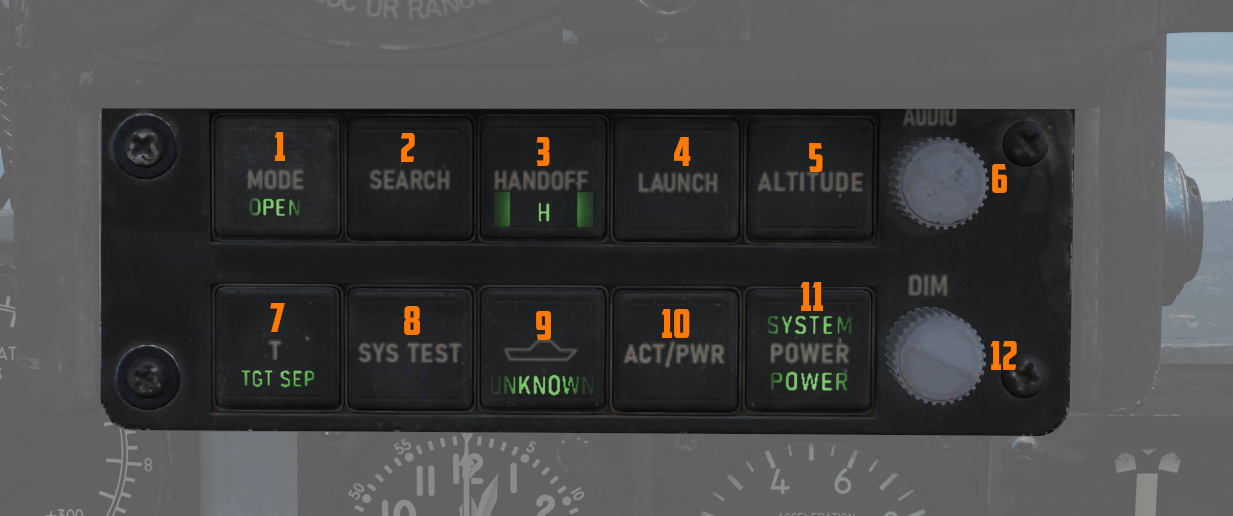
The ALR-46 Control Panel consists of ten multipurpose, illuminated buttons, along with a pair of rotary knobs for controlling the system's volume and panel brightness.
Controls are duplicated for pilot and WSO. The pilot controls are directly below the RWR Indicator, while the controls for the WSO are found below the Central Indicator in the front of the view.
Mode
The ALR-46 defaults on power-up to OPEN mode (
Search
By default, the ALR-46 is programmed to prioritize and display emitters tied to weapons that can
engage and destroy the aircraft. However, missions will require monitoring of early warning and
search radar systems working with longer pulse-widths for extended range detection and tracking of
possible intruders - i.e., the F-4. These emitters can be displayed using the Search mode
(
Because of their low threat priority, it is important to note that search radar symbology may often fall off the display due to their reduced importance - especially when the ALR-46 is placed into PRIORITY mode.
Handoff
The Handoff button (
In the event that the emitter is tight grouping of other symbols on the display, the TGT SEP mode will be applied.
When diamond symbol is latched, the diamond (handoff) audio can be heard through the intercom. It's a constant synthetical tone generated in the system based on the current PRF (pulse repetition frequency) of the given emitter. It's not affected by the received power so the amplitude won't change in time as in some other systems.
Launch
In the event a missile launch is detected by way of discrete SAM guidance commands being received,
the MISSILE LAUNCH indications in this button (
💡 Keep in mind that ALR-46 can detect missile launches only from certain systems.
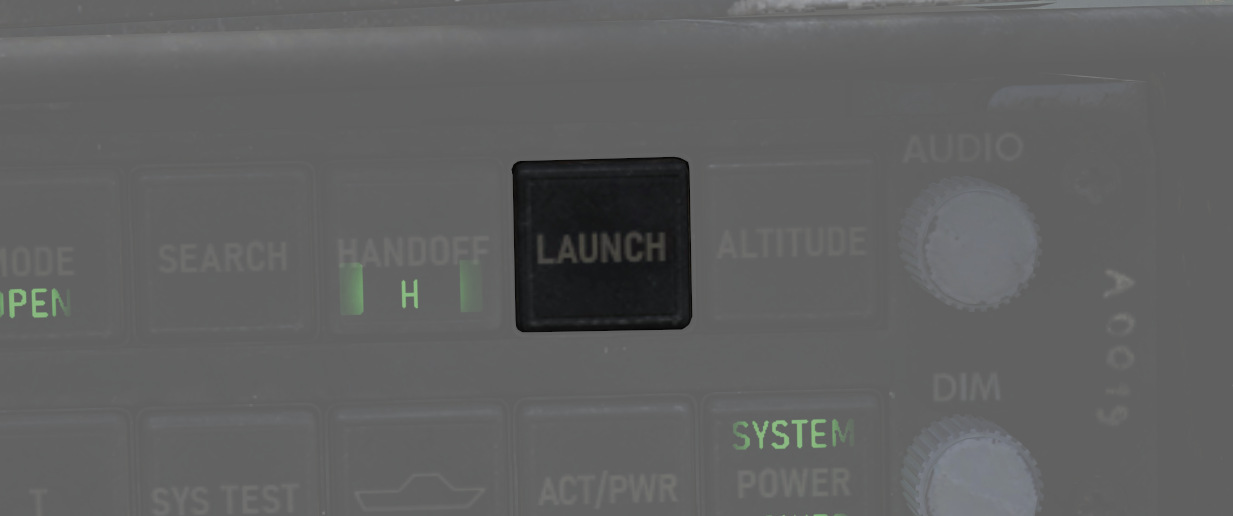
Altitude
The ALR-46 utilizes own-ship altitude as a defining aspect of threat priority, thus causing low
altitude AAA and SAM threats to lose priority in the event the aircraft is at an altitude that is
estimated to place it outside of their threat envelope. Activating LOW ALT mode (
Target Separation
In the event of a number of emitters being detected at such close proximity that the symbology
overlaps on the RWR display, the Target Separation button (
System Test
The system power on test (
This button is also used when switching the threat files. Exact procedure is explained in the symbology section.
Unknown
When an emitter is detected that does not have a catalog entry, but is recognized by received power,
duration, and pulse as being a possible threat, the U indicator on the Unknown button (
The default condition of the Unknown button is with the U symbol illuminated, but steady.
Activity Power
In the event SAM guidance commands are detected, the ACTIVITY button (
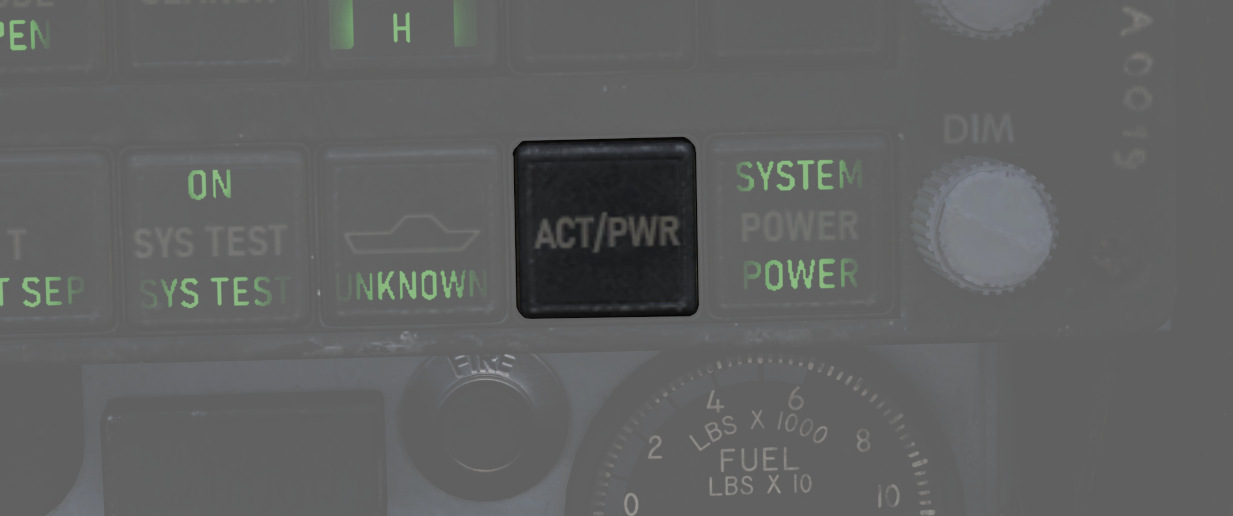
System Power
The System Power button (
In the event of a system power failure, the ALR-46 has an automatic restart function. Once power is recovered, the receiver will restart after a fifteen-second delay, in addition to its 9-second power on self test. The system will resume state in the same fashion as a normal restart - with Search mode deactivated and the altitude priority as when power was lost.
Audio Knob
The AUDIO Knob (
DIM Knob (Dimmer)
The DIM knob (
Audio Alerts
New Guy Audio
The audio alert issued when a new emitter is first displayed, or when PRF (pulse repetition frequency) of an existing display changes is known as new guy audio. It consists of three beeps within 1.5 seconds, each at PRF of emitter which has diamond symbol. The new guy audio alerts a crew-member to a change in threat environment so he can check his azimuth indicator for update. The AUDIO control on indicator-control can adjust volume from maximum to completely off.
💡 You can listen to the various sounds at officialdsplayer.github.io/F-4E-RWR-PRF-Library.
Launch Audio
The synthetic launch tone generated when an emitter goes into launch state is called launch audio or ML interrupt audio. It consists of approximately seven beeps in 1.5 seconds of a 1 kHz tone generator in the signal processor. Only one launch audio is generated per launch; i.e., after approximately seven beeps, no launch audio is heard from that emitter.
Volume of the launch audio is controlled by the main RWR audio knob as well as dedicated ML audio knob in each cockpit. The resultant volume is a function of both knobs positions.
Symbology
The ALR-46 features a limited number of symbols for the different radar threats. The following symbols can stand for the different threats. The ALR-46 can save up to three files containing threat tables.
- Land file (default) - land and air threats
- Sea file - sea and air threats
- Training file - additional configurable threats (empty by default)
The Pilot can switch between the land and the training file by simply pressing the SYS TEST
(
Land and Air based Threats
| Symbol | Possible threat |
|---|---|
 | SA-2 S-75 "Fan Song" TR |
 | SA-2 S-75 RD-75 Amazonka RF |
 | SA-3 S-125 "Low Blow" TR |
 | SA-5 S-200 "Square Pair" TR |
 | SA-6 Kub "Straight Flush" TR |
 | HQ-7 TR |
 | Osa 9A33 ln |
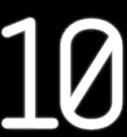 | SA-10 S-300PS "Flap Lid" |
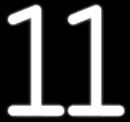 | SA-11 9K37 Buk |
 | SA-15 9K331 Tor |
 | SA-19 2k22M Tunguska |
 | ZSU-23-4 Shilka |
 | Fire Can SON-9 |
 | Gepard, C-RAM Phalanx |
 | MIM-23 Hawk |
 | MIM-104 Patriot |
 | Rapier, Roland |
 | SA-6 Kub "Straight Flush" SR, Roland SR, C-RAM Phalanx SR, PPRU-1 "Dog Ear", HQ-7 SR, Hawk CWAR, NASAMS, Rapier Dagger, SA-11 Snow Drift, SA-10 "Big Bird", S-300PS 40B6MD SR |
 | E-2D Hawkeye, E-3C Sentry, A-50 |
 | F-14, F-15C, F-15E, F-16, F-18C, JF-17, M-2000C, MiG-29, Su-27, MiG-31, Tornado IDS/GR4 |
 | F-1, AJS-37, F-4E, MiG-19, MiG-21, MiG-23, F-5E-3 |
 | Unknown (Low band) |
 | Unknown (Medium band) |
 | Unknown (High band) |
Sea and Air based Threats
| Symbol | Possible threat |
|---|---|
 | Rezky, Albatros |
 | Battlecruiser Pyotr Velikiy, Cruiser Moskva, Type 052C Destroyer, Frigate Neustrashimy |
 | Type 054A Frigate, Type 052B Destroyer |
 | CV 1143.5 Kuznetsov |
 | La Combattante II |
 | Type 071, Leander Class |
 | Ropucha Class |
 | CVN-71 Theodore Roosevelt, CVN-72 Abraham Lincoln, CVN-73 George Washington, CVN-74 John C Stennis, CVN-75 Harry S. Truman, USS Forrestral, LHA Tarrawa |
 | O.H. Perry |
 | Leander Class |
 | Ticonderoga, USS Arleigh Burke |
 | Rezky Head Net SR, Neustrashimy SR, Invincible SR, Leander SR, Slava Class SR, Kuznetsov SR, Ropucha SR |
 | E-2D Hawkeye, E-3C Sentry, A-50 |
 | F-14, F-15C, F-15E, F-16, F-18C, JF-17, M-2000C, MiG-29, Su-27, MiG-31, Tornado IDS/GR4 |
 | F-1, AJS-37, F-4E, MiG-19, MiG-21, MiG-23, F-5E-3 |
 | Unknown (Low band) |
 | Unknown (Medium band) |
 | Unknown (High band) |
Missiles
| Symbol | Possible threat |
|---|---|
 | Correlated missile |
 | Uncorrelated missile |
Threat Indications
Due to weapon systems all operating very differently, the RWR indications always have to be interpreted individually per threat platform. This requires understanding how the expected threats work, how they guide missiles, whether they have separate search and tracking radars or similar.
The following table gives an overview on how the RWR indicates certain events for commonly faced threats.
Actual missile launches can only be detected by the presence of C/D band guidance signals, indicated by the LAUNCH lamp. This is the case for some SAM systems. Some actively guided radar missiles can be identified individually and will be shown with specific Missile symbols.
Beyond those clear indications, missile launches are often preceded by the target platform activating a specific tracking-radar or significantly increasing its PRF, which the RWR often picks up and plays a New-Guy tone for (3 short beeps). Activating HANDOFF mode often makes the high pitched PRF tone clearly audible.
💡 The presence of a tracking radar does not necessarily indicate a lock, that the weapon platform intents to shoot or that the own aircraft is the target. However, in practice this is very often the case.
💡 Symbols S and U require activating the SEARCH and UNKNOWN mode respectively to be shown on the screen.
💡 The following threats and their indications (except launch) are applicable only for the respective threat table that the ALR-46 is currently using. For example, the Rezky's tracking radar will display as a 4 on the sea file (as listed below) but will display as an 8 when using the land file. It is important to be using the correct threat table for the expected threats or confusion may occur.
Land
| Threat | Search | Track/Lock | Launch |
|---|---|---|---|
| SA-2 | S | 2 | 🟢 |
| SA-3 | S | 3 | 🟢 |
| SA-5 | S | 5 | ❌ |
| SA-6 | S | 6 | 🟢 |
| HQ-7 | S | 7 | ❌ |
| SA-8 | U | 8 | 🟢 |
| SA-10 | S | 10 | ❌ |
| SA-11 | S | 11 | ❌ |
| SA-13 | U | ❌ | ❌ |
| SA-15 | U | 15 | 🟢 |
| SA-19 | U | 19 | ❌ |
| Hawk | S (CWAR Only) | H | ❌ |
| Patriot | P | PRF change | ❌ |
| Rapier | S | R | ❌ |
| NASAMS | S | ❌ | AIM-120 tracking 🟢, other ❌ |
Sea
💡 Majority of naval vessels have multiple radars for their multiple weapon systems. Only some of them are included in the RWR's threat library, therefore only the highest priority threat is shown in the lock column in the table below.
| Threat | Search | Lock | Launch |
|---|---|---|---|
| Rezky | S (Multiple radars some U) | 4 | 🟢 |
| Kirov | S (Multiple radars some U) | 6 | ❌ |
| Slava | S (Multiple radars some U) | 6 | 🟢 |
| Kuznetsov | S (Multiple radars some U) | 9 | ❌ |
| Molniya | U | 8 | 🟢 |
| Grisha | U | 8 | 🟢 |
| Neustrashimy | S (Multiple radars some U) | 9 | ❌ |
| Ropucha | U | A | ❌ |
| Type 052B | S (Multiple radars some U) | 7 | ❌ |
| Type 052C | U | 6 | ❌ |
| Type 054A | U | 7 | ❌ |
| Type 071 | U | A | ❌ |
| Ticonderoga | P | P | ❌ |
| Arleigh Burke | P | P | ❌ |
| Oliver Hazard Perry | U | G | ❌ |
| Forrestal | U | C | ❌ |
| Nimitz | U | C | ❌ |
| Tarawa | U | C | ❌ |
| La Combattante II | U | A | ❌ |
| Leander | S (Multiple radars some U) | L | 🟢 |
| Castle | U | ❌ | ❌ |
| Invincible | S (Multiple radars some U) | ❌ | ❌ |
| Veinticinco de Mayo | U | ❌ | ❌ |
| Condell | U | ❌ | ❌ |
| Tiger | U | ❌ | ❌ |
Air
| Threat | Search | Lock | Launch |
|---|---|---|---|
| MiG-19 | 🟢 | PRF change | ❌ |
| MiG-21 | 🟢 | PRF change | ❌ |
| MiG-23 | 🟢 | PRF change | ❌ |
| MiG-29 | 🟢 | PRF change | R-77 tracking 🟢, other ❌ |
| Su-27/30/33/34/J-11 | 🟢 | PRF change | R-77 tracking 🟢, other ❌ |
| JF-17 | 🟢 | PRF change | ❌ |
| F-4 | 🟢 | PRF change | ❌ |
| F-5 | 🟢 | PRF change | ❌ |
| F-14 | 🟢 | PRF change | AIM-54 tracking 🟢, other ❌ |
| F-15 | 🟢 | PRF change | AIM-120 tracking 🟢, other ❌ |
| F-16 | 🟢 | PRF change | AIM-120 tracking 🟢, other ❌ |
| F-18 | 🟢 | PRF change | AIM-120 tracking 🟢, other ❌ |
| Mirage F1 | 🟢 | PRF change | ❌ |
| Mirage 2000C | 🟢 | PRF change | ❌ |